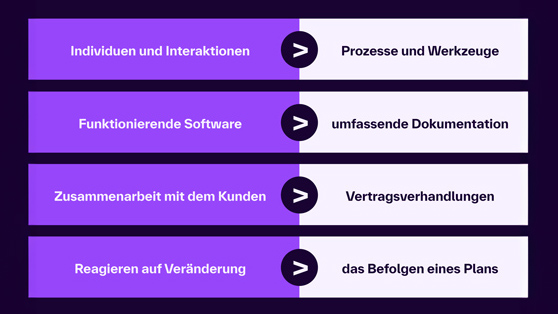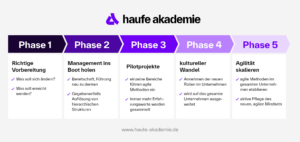The rules of the game in the world of work are changing rapidly - and more and more companies are realizing this: If you want to be successful in the long term, you have to remain flexible and adaptable. But what exactly does that mean? In this article, you will find out how agile transformation really works and how it can be successfully implemented. Ready to make your company fit for the future?
The most important facts in brief
- Agile transformation means that a company can adapt to constantly changing circumstances with the help of agile methods and a holistic cultural change.
- Customer satisfaction, efficient processes and short decision-making paths are at the heart of agile transformation.
- Well-known agile frameworks are Scrum and Kanban. Efficient change management and agile leadership are also necessary to implement an agile transformation.
Definition: What does agile transformation mean?
Agile transformation is a comprehensive cultural change within an organization. The main goal of agile transformation is to be able to react flexibly to constantly changing conditions. It is therefore not just about implementing individual projects and processes in an agile way; rather, the entire corporate structure is changed.
Traditional hierarchies are therefore replaced in an agile transformation. Each team member should be empowered to act independently and make important decisions . Roles are no longer rigidly assigned, but can change again according to requirements.
What does "agile" actually mean?
Agility is the ability to adapt again and again. Anything that has this characteristic can also be described as agile. In addition to agile transformation, there are also agile processes, methods, leadership and agile project management.
What does agile working mean?
Unlike rigid processes, where everything is strictly planned, agile working emphasizes the self-organization of the teams. Projects are completed in small, repeated cycles (iterative development). In practice, frameworks such as Scrum or Kanban are used for this purpose.
Especially in the field of software development, the term "agile" is used as a generic term for agile project management and the philosophy behind it.
What is the opposite of agile?
Especially in companies with hierarchical structures, the so-called waterfall method is often used. Projects are divided into different phases that are worked through in the exact order specified. Spontaneous adjustments and reactions to new requirements are not possible here, which is why this method is more suitable for constant projects with predictable processes.
The origin of Agile
Back in 2001, 17 US software developers formulated the so-called Manifesto for Agile Software Development. It contains brief statements that highlight what should be prioritized in day-to-day work. The decisive factor for this project was that traditional, planning-intensive methods were no longer able to meet the requirements of fast-moving markets back in the 1990s.
In the manifesto, the values on the left are rated higher than the aspects on the right.

To this day, the core message of these values has never lost its relevance.
Goals of an agile transformation
The aim of agile is to develop products or services that precisely meet the current needs of customers through regular feedback and continuous improvements. In the course of an agile transformation, the company structure should therefore be changed in such a way that the following goals can be achieved:
- Customer satisfaction
- Satisfaction in the team
- Simplified and efficient processes
- Increased resilience of the company
The need for an agile transformation may have been apparent in the company for some time. The following "symptoms" may indicate that a fundamental reorganization of existing structures is worthwhile:
Customer satisfaction is declining
- Former existing customers are increasingly buying from the competition.
- Complaints about the services provided are piling up.
- New customers are difficult to reach.
- The target group has become unclear.
The team is dissatisfied
- The team members feel poorly informed and hardly involved in the company's activities.
- Many people in the company feel held back and see little room for maneuver.
- Surveys on employee satisfaction are sobering.
- New Employees leave the company after a few years.
The processes are too complex
- Feedback loops take a long time and often get stuck at certain points.
- Ideas from the team are regularly discarded because it would take too long to adapt the processes.
- Products and services are preceded by very long development periods. During this time, the process repeatedly comes to a standstill or is broken off completely.
- In general, there is a feeling that progress is very slow and that the proposals for change are initially met with great skepticism.

Whitepaper: Rethinking change
Discover in the free white paper how you can successfully shape the transformation with agile methods and immerse yourself in the leadership, structure and culture of agile transformation management.
Download free of charge
Why an agile transformation pays off
Climate change, geopolitical tensions, social media, new work: the clocks are ticking faster and faster and hardly any industry remains untouched by the constantly changing framework conditions. Companies now have the opportunity to actively shape the future instead of passively enduring and being at the mercy of external influences. The following 5 reasons show how companies can benefit from an agile transformation.
1. market launches become faster
With agile frameworks such as Scrum or Kanban, projects can be divided into many small intermediate steps. Feedback is provided after each step, allowing improvements to be made right from the start.
What initially sounds like extra work actually has the exact opposite effect: as errors often "pile up" until the end of the development cycle in traditional product development, there is hardly any time left to rectify them at the end. With the agile method, these problems are eliminated on-the-go.
As the Employees are allowed to make decisions themselves, there are no long feedback loops. The strong communication between all those involved clarifies questions quickly and work can continue efficiently without the project coming to a standstill.
2. customers are more satisfied
Satisfied customers are at the heart of agile transformation. Ideally, they are involved in all steps of the development of new products or services. In this way, the company always receives answers to the following questions:
- Is the planned product relevant at all?
- What properties must it have?
- Which features may not provide the hoped-for added value?
If customer needs change, agile teams can react in good time and ultimately bring the service to the market that offers real added value for the target group.
Agility or waterfall method for greater customer satisfaction?
Some managers stick to traditional management methods due to the seemingly predictable profit. However, there is a risk here of "bypassing" the actual target group, as they are never really involved in product development.
3. Employees are more balanced
Agile working can make a significant contribution to employee satisfaction because it automatically entails the following aspects:
- Personal responsibility
- open feedback culture
- Simple and fast communication channels
Seeing a sense of purpose in their daily work is more fulfilling for most people than their salary. If people in the company feel empowered to actively shape things without constantly being held back, this motivates knowledge workers in particular immensely.
4. specialists become aware of the company
Talented specialists are looking for a job that offers them creative freedom and allows them to actively contribute their own expertise. In order to attract the best minds to your own company, a future-oriented approach is a decisive advantage.
Companies that opt for an agile transformation signal an innovation-friendly mindset, openness and a willingness to embrace positive change. They offer their specialists flexible working models and freedom of choice. Aspects that will continue to gain relevance in the future.
5. changes are less threatening
Agile companies are more resilient, which means that they are less easily shaken by crisis situations and react more quickly to new circumstances. This is possible thanks to short decision-making paths and Employees who are actively involved. In rigid constructs, on the other hand, an external crisis situation can permanently shake the internal framework.
For which companies is an agile transformation suitable?
In theory, an agile transformation can take place in any company. After all, all industries are confronted with advancing digitalization, enormous competitive pressure and external influences that can change rapidly. The types of companies that can generally implement an agile transformation well include
- Microenterprises
- IT and software companies
- Financial service provider
- Provider of digital services
- Agencies and consulting firms
However, not all companies cope equally well with fundamental changes to the overall corporate structure. Why is that?
The challenges: Where agile transformation can fail
Agile transformation has a deep impact on existing structures, which can cause large companies with traditional top-down hierarchies in particular to stumble. If a company fails because of the new organizational structure, it is probably due to one of the following 3 reasons.
The management level rejects change
No real agile transformation can take place in companies that prefer a hierarchical management style. The concept requires acting at eye level and a flexible distribution of roles that can change constantly.
Employees are not properly involved
Agile transformation only works if everyone in the company is equally involved. Giving instructions from the top down is therefore not enough and even contradicts the actual concept.
The agile transformation is not considered holistically
Introducing agile methods in individual departments while other areas remain unaffected is not an agile transformation. Such measures can help to simplify the respective processes; however, when applied in isolation, the added value is not transferred to other areas and certainly not to the entire company.
Recommended reading
What skills does agile leadership need?
Engagement and commitment at management level are crucial for an agile transformation to succeed. In this article, we reveal which skills managers need in the modern working world.
To the article
How agile transformation can succeed
So how can an agile transformation successfully take place in a previously traditional or less flexible company?

Phase 1: the right preparation
The first phase lays the foundation for the success of the agile transformation. It defines what needs to change and what exactly needs to be achieved. Clear communication, common objectives and comprehensive information are necessary for this.
Phase 2: getting management on board
It is not possible without the support of management. They must be prepared to abolish previous hierarchical structures if necessary and to organize decision-making paths differently in the future. This requires a cultural change, i.e. the willingness to think differently about leadership than before.
In agile management, managers ideally see themselves as supporting their teams. The focus is therefore no longer on simply passing on instructions from a higher level.
Phase 3: Testing with pilot projects
An agile transformation cannot be rolled out to the entire company overnight. To begin with, it is advisable to test agile methods in certain areas. Ideally, this should not be limited to a single area, but to 2-3 different departments, for example, which are not currently working at full capacity.
In this way, the pilot teams gather a range of experience that can be shared with each other. It is important to know and accept that these projects can also fail. It is crucial to value this experience as an increase in knowledge instead of writing off the agile transformation project altogether.
Phase 4: cultural change
Ideally, cultural change within the company takes place right from the start, but at the latest when the agile transformation is rolled out to the entire organization following successful pilot projects. Among other things, cultural change means understanding one's own new role within the company.
This affects the management level the most, especially if it has previously operated according to a classic hierarchical scheme.
How long does cultural change take?
Agile transformation and the associated cultural change are not processes that are finally completed at a certain point. Particularly in larger companies , an agile transformation can take several years until the agile self-image has arrived in all areas. Cultivating the new culture is an ongoing process.
Phase 5: Scaling the new agility
Scaled agility or agile scaling means establishing the new agile methods on a corporate scale. What has worked successfully in individual departments to date should now be applied to the entire organization. Now it is important not to fall back into old patterns and to actively maintain the newly acquired agile mindset.

Bring about change now as an Agile Transformation Manager:in
This Future Jobs Class will provide you with extensive expert knowledge, instructions for agile and traditional methods as well as practical tips to ensure the adaptability and thus the success of your company.
Discover the Future Jobs Class
6 important terms relating to agile transformation
| Term | Explanation |
|---|---|
| Agile leadership | Agile managers act in the spirit of agile transformation. They place people (their teams and customers) at the center of their decisions. They see themselves as a support for their expert teams and not as a directive authority. |
| Change management | Change management is important for agile transformation in order to accompany the far-reaching change processes in a structured manner. Change management is therefore a tool that is used in the implementation of agile transformation. |
| Community of Practice | A Community of Practice (CoP) refers to a group of people who work together to solve a problem that affects everyone involved. CoP is a popular method for solving problems in agile organizations. |
| Kanban | Kanban is a Japanese concept based on a board. In this method for agile project management, the board is divided into columns that are read and filled from left (tasks still to be completed) to right (tasks completed). |
| Scrum | Scrum is a framework for agile project management. Part of it are the so-called sprints, during which a task is to be completed. There are regular exchanges with the team members (daily stand-ups) and feedback rounds at the end of the sprints (retrospective). |
| Spiral Dynamics | Spiral Dynamics is a development model that outlines how the values and skills of people, organizations and societies evolve over time. The model offers exciting starting points for implementing an agile transformation. |
Frequently asked questions about agile transformation
What is an agile transformation in simple terms?
Agile transformation means that an organization changes fundamentally in order to be able to react better and faster to changes. The aim is to remain flexible and adapt quickly to new conditions. The focus is on customer satisfaction, simplified processes and balanced, independent Employees.
Are agile transformation and change management the same thing?
No, because agile transformation describes a holistic process that basically has no specific end point. Change management is a tool for professionally supporting change processes. Change management involves individual measures that can contribute to agile transformation, but which have a defined conclusion.
What are agile methods?
Agile methods are working techniques that enable a high degree of flexibility and rapid response to feedback. Well-known frameworks for agile working are Scrum or Kanban. Agile methods contribute to the agile transformation of a company. However, without the associated cultural change, no actual agile transformation will take place.




